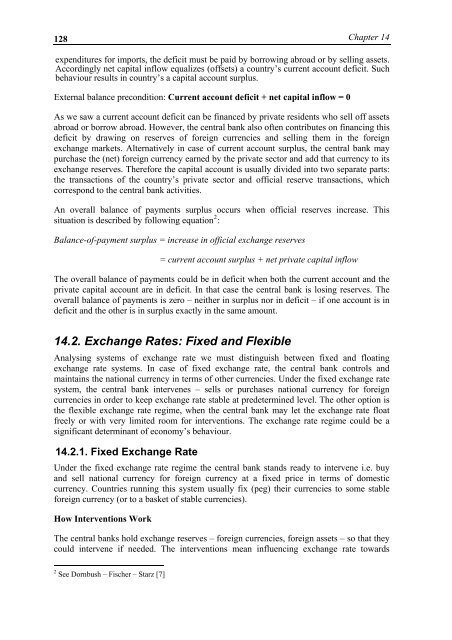MacroeconomicsI_working_version (1)
Create successful ePaper yourself
Turn your PDF publications into a flip-book with our unique Google optimized e-Paper software.
128<br />
Chapter 14<br />
expenditures for imports, the deficit must be paid by borrowing abroad or by selling assets.<br />
Accordingly net capital inflow equalizes (offsets) a country’s current account deficit. Such<br />
behaviour results in country’s a capital account surplus.<br />
External balance precondition: Current account deficit + net capital inflow = 0<br />
As we saw a current account deficit can be financed by private residents who sell off assets<br />
abroad or borrow abroad. However, the central bank also often contributes on financing this<br />
deficit by drawing on reserves of foreign currencies and selling them in the foreign<br />
exchange markets. Alternatively in case of current account surplus, the central bank may<br />
purchase the (net) foreign currency earned by the private sector and add that currency to its<br />
exchange reserves. Therefore the capital account is usually divided into two separate parts:<br />
the transactions of the country’s private sector and official reserve transactions, which<br />
correspond to the central bank activities.<br />
An overall balance of payments surplus occurs when official reserves increase. This<br />
situation is described by following equation 2 :<br />
Balance-of-payment surplus = increase in official exchange reserves<br />
= current account surplus + net private capital inflow<br />
The overall balance of payments could be in deficit when both the current account and the<br />
private capital account are in deficit. In that case the central bank is losing reserves. The<br />
overall balance of payments is zero – neither in surplus nor in deficit – if one account is in<br />
deficit and the other is in surplus exactly in the same amount.<br />
14.2. Exchange Rates: Fixed and Flexible<br />
Analysing systems of exchange rate we must distinguish between fixed and floating<br />
exchange rate systems. In case of fixed exchange rate, the central bank controls and<br />
maintains the national currency in terms of other currencies. Under the fixed exchange rate<br />
system, the central bank intervenes – sells or purchases national currency for foreign<br />
currencies in order to keep exchange rate stable at predetermined level. The other option is<br />
the flexible exchange rate regime, when the central bank may let the exchange rate float<br />
freely or with very limited room for interventions. The exchange rate regime could be a<br />
significant determinant of economy’s behaviour.<br />
14.2.1. Fixed Exchange Rate<br />
Under the fixed exchange rate regime the central bank stands ready to intervene i.e. buy<br />
and sell national currency for foreign currency at a fixed price in terms of domestic<br />
currency. Countries running this system usually fix (peg) their currencies to some stable<br />
foreign currency (or to a basket of stable currencies).<br />
How Interventions Work<br />
The central banks hold exchange reserves – foreign currencies, foreign assets – so that they<br />
could intervene if needed. The interventions mean influencing exchange rate towards<br />
2 See Dornbush – Fischer – Starz [7]




